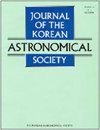MONTE-CARLO RADIATIVE TRANSFER MODEL OF THE DIFFUSE GALACTIC LIGHT
IF 0.8
4区 物理与天体物理
Q3 ASTRONOMY & ASTROPHYSICS
引用次数: 8
Abstract
Monte-Carlo radiative models of the diffuse Galactic light (DGL) in our Galaxy are calcu-lated using the dust radiative transfer code MoCafe, which is three-dimensional and takes full account of multiple scattering. The code is recently updated to use a fast voxel traversal algorithm, which has dramatically increased the computing speed. The radiative transfer models are calculated with the gen-erally accepted dust scale-height of 0.1 kpc. The stellar scale-heights are assumed to be 0.1 or 0.35 kpc, appropriate for far-ultraviolet (FUV) and optical wavelengths, respectively. The face-on optical depth, measured perpendicular to the Galactic plane, is also varied from 0.2 to 0.6, suitable to the optical to FUV wavelengths, respectively. We find that the DGL at high Galactic latitudes is mostly due to backward or large-angle scattering of starlight originating from the local stars within a radial distance of r < 0.5 kpc from the Earth. On the other hand, the DGL measured in the Galactic plane is mostly due to stars at a distance range that corresponds to an optical depth of ? 1 measured from the Earth. Therefore, the low-latitude DGL at the FUV wavelength band would be mostly caused by the stars located at a distance of r . 0.5 kpc and the optical DGL near the Galactic plane mainly originates from stars within a distance range of 1 . r . 2 kpc. We also calculate the radiative transfer models in a clumpy two-phase medium. The clumpy two-phase models provide lower intensities at high Galactic latitudes compared to the uniform density models, because of the lower effective optical depth in clumpy media. However, no significant difference in the intensity at the Galactic plane is found.漫射星系光的蒙特卡罗辐射传递模型
利用尘埃辐射传输代码MoCafe计算了银河系漫射光(DGL)的蒙特卡洛辐射模型,该模型是三维的,充分考虑了多重散射。该代码最近更新为使用快速体素遍历算法,这大大提高了计算速度。辐射传输模型采用普遍接受的尘标高度0.1 kpc进行计算。假设恒星尺度高度为0.1或0.35 kpc,分别适用于远紫外(FUV)和光学波长。垂直于银面测量的表面光学深度也在0.2到0.6之间变化,分别适用于光波长和FUV波长。我们发现,银河系高纬度地区的DGL主要是由于距离地球径向距离r < 0.5 kpc的本地恒星发出的星光向后或大角度散射造成的。另一方面,在银河面测量的DGL主要是由于恒星的距离范围对应于光深为?1从地球测量。因此,FUV波段的低纬度DGL主要是由距离r的恒星引起的。0.5 kpc和银河面附近的光学DGL主要来自距离范围为1的恒星。r。2 kpc。我们还计算了块状两相介质中的辐射传递模型。由于团块介质的有效光学深度较低,因此团块两相模型在银河系高纬度提供的强度比均匀密度模型低。然而,在银道面没有发现明显的强度差异。
本文章由计算机程序翻译,如有差异,请以英文原文为准。
求助全文
约1分钟内获得全文
求助全文
来源期刊

Journal of the Korean Astronomical Society
地学天文-天文与天体物理
CiteScore
1.30
自引率
10.00%
发文量
0
审稿时长
>12 weeks
期刊介绍:
JKAS is an international scientific journal publishing papers in all fields of astronomy and astrophysics. All manuscripts are subject to the scrutiny of referees. Manuscripts submitted to JKAS must comply with the ethics policy of JKAS. Six regular issues are published each year on February 28, April 30, June 30, August 31, October 31, and December 31. One year''s issues compose one volume.
 求助内容:
求助内容: 应助结果提醒方式:
应助结果提醒方式:


